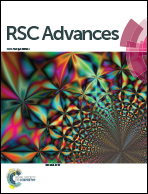Electrospun zinc oxide nanofibers for direct selective electrochemical detection of biological compounds†
Abstract
An electrochemical method for simultaneous determination and direct electro-oxidation behaviors of ascorbic acid (AA), uric acid (UA) and folic acid (FA) was developed at a zinc oxide nanofibers modified carbon paste electrode (ZNFs/CPE). Scanning electron microscopy (SEM) and transmission electron microscopy (TEM) techniques were used to examine the structure of the zinc oxide nanofibers. The measurements were carried out using cyclic voltammetry (CV) in citrate buffer solution with pH 5.5. This modified electrode exhibits potent and persistent electro-oxidation behavior followed by well-separated oxidation peaks toward AA, UA and FA with increasing oxidation current. The electrochemical behaviors of AA, UA and FA on the modified electrode were carefully studied by cyclic voltammetry, and the electrochemical parameters, such as the area of the electrode (A), the electron transfer number (n), the electron transfer coefficient (α), diffusion coefficient (D) and the electrode reaction standard rate constant (ks), were calculated. Differential pulse voltammetry (DPV) was proposed for simultaneous determination of these three analytes. Under the selected conditions the oxidation peak currents were proportional to AA, UA and FA concentrations in the range from 0.9 to 100 μM, 0.7 to 1000 μM and 0.2 to 500 μM with the limits of detection (LOD) as 0.013, 0.028 and 0.036 μM (3σ), respectively. The proposed method showed good selectivity to the AA, UA and FA detection without the interferences of coexisting substances.


 Please wait while we load your content...
Please wait while we load your content...